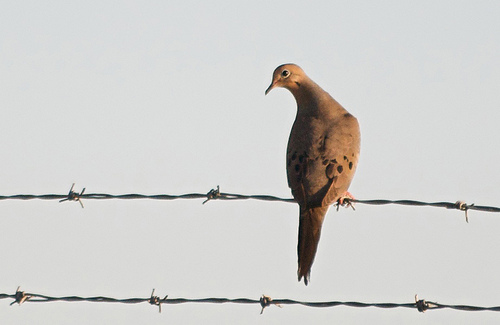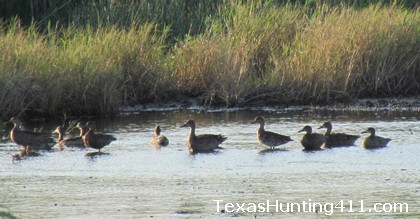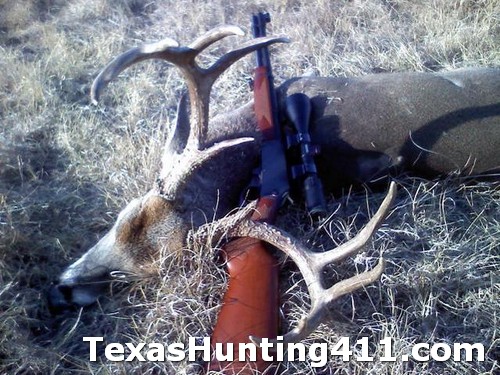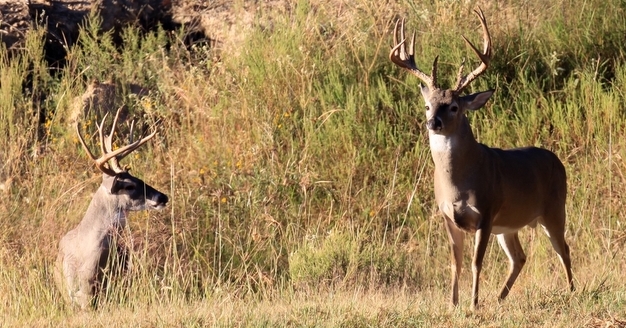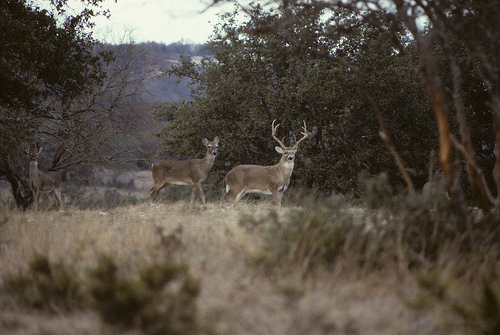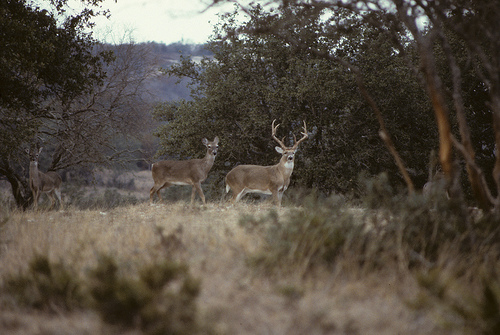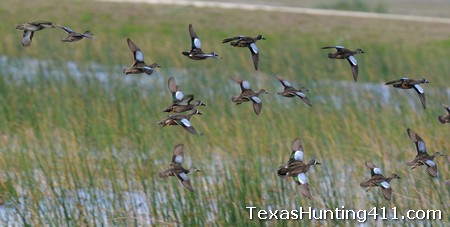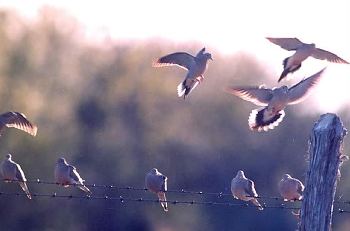The key to great bobwhite quail hunting can be found in providing high quality habitat. The South Texas Plains and the Rolling Plains of north-central Texas offer the best overall areas for quail hunting and habitat in the state. In relative terms, the overall habitat types occurring in other regions, such as the Edwards Plateau or the eastern side of the Cross Timbers region of central Texas are not known as some of the better quail producing areas of the state. The truth of the matter though is that it can be difficult to manage for quail, even in areas and on properties that provide good quail habitat.
That is because quail populations vary greatly from year to year, even in the best quail producing parts of Texas. The timing and amount of fall and winter rainfall are thought to be the most critical factors that determine quail breeding success and survivability during the next year. Adequate amounts of fall/winter rains are necessary for the soil moisture that promotes the early growth of herbaceous plants, which quail require. It takes several good years to really grow a quail population. Many quail die naturally each winter, whether or not they are hunted, so it takes decent conditions year-in and year-out to maintain a population. Quail populations, like quail hunting in Texas, are boom or bust. The land, however, must be managed for quail in order to take advantage of the rainfall that nature provides.
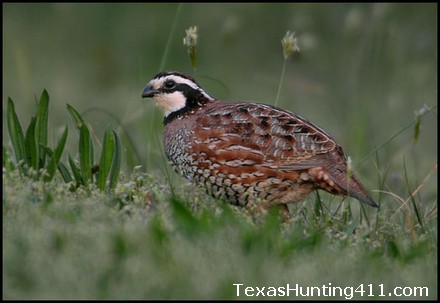
Quail Habitat Management for Food Production
Bobwhite quail must have a year-round adequate supply of food and reasonable protection from hazards. This includes protection from predators while feeding, resting, loafing, roosting, traveling, and nesting, as well as protection from inclement weather conditions. Both food and cover supply must be stable or continuously renewed during the entire year. It is not enough that food and cover be adequate for 11 months, if either is lacking during a single month.
Food and cover must occur in an well-arranged pattern if they are to comprise quail habitat. The distance between a source of ample food and adequate cover must not be greater than bobwhites can negotiate with safety. As a rule of thumb, bobwhites venture no further than 200 yards from patches of cover. Ideally, escape cover should be linked to food supplies with more or less continuous screening cover. The screening cover must not be dense enough to prove an obstacle to the quail’s short-legged gait. Overgrazed pastures do not provide adequate screening cover. On the flip side, dense stands of thick grass cannot be easily negotiated. Without a suitable space relationship, a range will not be habitable for quail regardless of the quality or amount of food and cover present.
Food supplies are usually most abundant during the spring and summer when seeds are ripening and insects and green plant material are available. The quail food supply begins to diminish at the time of the first killing frost in the fall, and continues to decline throughout the winter due to competition from other animals and from weathering. Seeds from forbs such as croton (doveweed), ragweed, sunflower, partridge pea, and many others are staple winter foods. A number of woody plants provide winter quail food.
Fruits and mast such as small acorns, sumac berries, hackberries, and gum elastic berries supplement quail diets. Most grasses, except for paspalums and panic grasses, do not produce seeds large enough to be worthwhile quail food. In general, forbs are the most important and most widely distributed sources of winter quail food. Green material from cool season forbs and grasses that germinate in the late winter if rainfall is adequate is essential to get quail in good body condition for the upcoming breeding season.
Quail Cover – Necessary for Good Habitat
Bobwhite quail need several types of cover: screening overhead cover for security while feeding and traveling, “tangled” woody cover to retreat into to escape enemies, a “living room” type of cover for dusting or resting, and nesting cover. Roosting cover is also needed, but if other types of cover are present, the roosting cover requirement is usually adequately met.
Cover can take many forms and a patch of cover can meet several of the cover requirements. A stand of broomweed, or similar tall plants with bushy canopies and an open understory at ground level, can provide screening overhead cover. Thickets of low brush, trees, and vines can provide escape and loafing cover. In general, a habitat with between 5% and 15% canopy coverage of good woody cover is adequate, if it occurs in small, well-distributed patches (no more than 200 yards between patches as discussed above).
Patches of residual grasses left over from the previous growing season can provide nesting cover. Individual patches should be at least 8 inches tall and 12 inches in diameter (the size of a cake pan). Ideally, there should be more than 250 well distributed clumps of suitable nesting cover per acre, or 1 clump every 15 to 20 steps. Too little nesting cover makes it easier for predators to find and destroy nests.
Quail Habitat Management Practices
A primary quail management objective is to maintain or create the mosaic of small thickets of low growing woody brush throughout a ranch, as described above in woody cover requirements. Thickets of sumac, briers, agarito, elbowbush, etc. should be retained and encouraged to form in the more open areas of the ranch. Although not as desirable, small clumps of low growing cedars could have some value as cover where other species do not grow or are in short supply. Small patches of low growing cover should be retained during brush clearing operations in the more densely wooded portions of the ranch.
Where vines have grown up into a tree but it is too open at ground level to serve as quail cover, the tree can be cut half through a few feet above ground and pushed over, bringing the living vines closer to the ground. The trunks of multi-stemmed mesquites can be half-cut and pushed over to where the limbs touch the ground but they still continue to grow, forming small areas protected from cattle grazing/deer browsing. Half-cutting mesquite should be done during the early and middle parts of the growing season, not during the dormant season. The “skeletons” of large cut cedars can also form small areas protected from grazing/browsing where patches of herbaceous and woody plants suitable for cover can become established.
The number of browsing animals on the range (combination of wildlife and domestic livestock) needs to be maintained at a level where browsing pressure on low growing woody cover is not excessive. The objective should be to improve the amount and quality of herbaceous cover. A well-planned deferred-rotation livestock grazing system can be used to create the patchy pattern of lightly grazed areas interspersed among more heavily grazed areas needed for nesting cover.
Most good seed producing forbs are early successional stage annuals that respond to soil disturbance that sets back plant succession. Disking the soil is a good habitat management practice for quail that encourages the growth of forbs and other annual plants. Disked strips should be long and meandering and 1 or 2 disc widths wide. The same strips can be disked annually, or side-by-side strips can be disked on an alternating basis every other year to create adjacent strips in various stages of succession. The best plant response will occur in areas of deeper soils. It is important that disked strips be located near escape cover so they are useable by quail. Disking can be done anytime between the first killing frost in the fall and the last frost in the spring, but the optimum time is near the end of winter (January, February) shortly before spring growth gets underway.
Heavy spot grazing by cattle, such as occurs around salt blocks, feed areas, and water, causes soil disturbance that encourages forb growth. Salt blocks and feeding areas should be moved around the ranch to create small patches of disturbed ground.
Managing the habitat for the production of native food plants and cover should be the primary management goal. Supplemental feeding and/or the planting of food plots are not a substitute for good habitat management. These practices should only be considered as “supplements” to the native habitat, not as “cure-alls” for low quality and/or poorly managed habitats. Food plots and feeders alone will not increase the number of quail a range can support if the supplies of other required habitat elements such as cover are limited.
Food Plots for Quail Management
Small food plots of seed producing plants including but not limited to millets, sorghum alum, and sorghum planted on deeper soils near cover can provide supplemental food sources during periods of extreme weather conditions. A limiting factor of supplemental food plots is the insufficient amount of rainfall received in central Texas during most years. During dry years when the production of native foods is limited and supplemental foods are most needed, supplemental plantings will also be failures. During good years in Texas when the production of native foods is adequate, food plots for quail may do well, but are not as necessary. Another limiting factor is that most types of supplemental plantings will have to be protected from livestock grazing by fencing the plot or deferring the pasture.
Supplemental Feeding for Quail Management
Feeding can provide supplemental food during extreme weather conditions, help hold quail in an area, and give hunters areas to key on while quail hunting. Broadcasting corn or sorghum along roads from a vehicle is one method of distributing supplemental feed. It can also be distributed from fixed feeders. An intensive feeding program would be one that provides 1 feeder per every 40 to 60 acres of quail habitat (feeders placed 440 to 540 yards apart in a grid pattern) so that every quail covey has access to several feeders.
One feeder per 75 acres may be sufficient. Feeders less dense than 1 per 160 acres may not provide much benefit. As with all other types of food sources, feeders need to be located near escape and screening cover to be useable by quail. Some limitations of supplemental feeding are: an intensive program can be expensive and labor intensive, feed use by other “non-target” birds and animals may be substantial, diseases and parasites can be spread at heavily used sites, predators learn to key on sites regularly used by quail, and, depending on the type of feeder used, they may have to be fenced from livestock and hogs (in areas where feral hogs are present).
Prescribed burning is an effective, low-cost habitat management tool that can be used to enhance plant diversity by stimulating production of a variety of woody plants, forbs, and grasses. Burning can be used to remove rank stands of herbaceous vegetation and plant litter that hinder quail movements.
Quail Management in a Nutshell
In summary, quail need good habitat to persist on any property and to provide recreational hunting opportunities. Food and all the different types of cover must be available year around and suitably arranged to have a good quail habitat. The number of quail a range can produce and support will be dependent on the habitat element that is most limited. In other words, if cover is the limiting factor, increasing the amount of food beyond that needed for the number of quail that can be supported by the cover will not increase the range’s quail carrying capacity, and vice versa. The rest is up to Mother Nature.
